Sunday, 11 July 2010: Brussels to Ghent
Written 12 July 2010
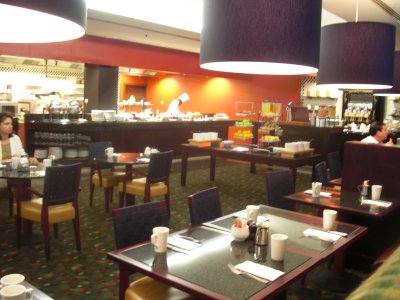 Here, at last, is a photo of part of the rather vast breakfast buffet at the Marriott Brussels, on our last morning at the hotel. Along the counter in front of the chef is the row of large chafing dishes. On the wall to the right of that you can see the three large metal milk dispensers and many jars of cereal. On a table nearer the camera are six white cylindrical crocks full of cut fruit, multitiered wire racks full of whole fruit, and liter bottles of sparking and still water. The breads and pastries are out of sight to the right of the photo.
Here, at last, is a photo of part of the rather vast breakfast buffet at the Marriott Brussels, on our last morning at the hotel. Along the counter in front of the chef is the row of large chafing dishes. On the wall to the right of that you can see the three large metal milk dispensers and many jars of cereal. On a table nearer the camera are six white cylindrical crocks full of cut fruit, multitiered wire racks full of whole fruit, and liter bottles of sparking and still water. The breads and pastries are out of sight to the right of the photo.
We had come to Belgium without making any advance arrangements for traveling from Brussels to Ghent, so we consulted the personnel at the hotel desk, and they assured us that trains ran that route every 30 min, all day, every day, even Sunday (when we needed to go). So the plan A was taxi from hotel to station, buy tickets, take the train to Ghent, taxi to the new hotel. That's a hassle with luggage, though, so we made further inquiries elsewhere and managed to negotiate what was probably a black-market taxi ride the whole way, door to door, for what we knew was rather more money than the initial plan. But that arrangement bothered me. It entailed leaving our luggage (and my computer!) in a car in a parking garage for several hours (from check-out time until the driver was free to take us), so we rethought, and on Sunday morning we tipped the driver, cancelled the door-to-door trip, and reverted to plan A.
The taxi stand was right in front of the hotel, we we hopped in a cab in midmorning and headed from the station, where we bought tickets for a train due in about 15 minutes. We reported to the requisite platform (up and down four different staircases, with our all our luggage). The train was eight minutes late, but just while we stood there, two others came and went (to other destinations). When the train pulled up, we opted for the lower level of the double-decker second-class car, but before I could wrestle my bags down the tiny staircase, all the seats were taken, and there was standing room only on the platform behind me. I settled in to stand (David, who boarded ahead of me) got a seat halfway down the car, but a young woman jumped up and offered me her seat. I demurred, but she pointed out that, unencumbered, she could easily find another place upstairs, whereas my luggage would make that hard for me. So I took her up on it (a perc of aging!) and had a comfy (and air-conditioned) seat for the rest of the 20-minute trip. A few minutes into the ride, the railroad people apologized over the PA system for the crowded conditions. Apparently some emergency had come up and they had only half the normal number of cars available.
For much of the ride the tracks were sunken between banks, but what scenery we could see, from time to time, was agrarian, punctuated by villages of mostly modern houses (though older agricultural structures, mostly barns, were visible on the farms). I saw corn, what could have been potatoes, and grain (considering all the beer, probably barley). Some white (beef?) cattle and some white, white spotted with brown, and black cattle. A few of those huge modern windmills for power generation. No vines or hops.
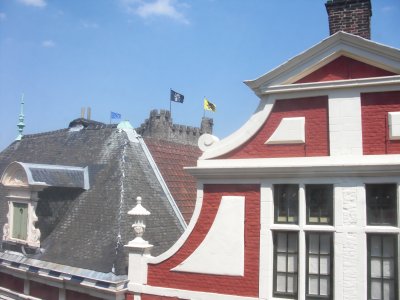 No trouble getting a cab at the train station, so we were whisked rapidly to our hotel, the Gravensteen, so called because it's just yards from Gravensteen Castle, the seat of the Counts of Flanders. David says he remembers it vividly from our 1983 visit, when we were shown its museum of torture instruments, which still haunts his dreams. Here's the view of the castle from our hotel room, over the roofs of the neighboring houses. The front of the hotel is much closer to it. To the right of it, out of this photo and nearly as close, is another Great Crane of Europe.
No trouble getting a cab at the train station, so we were whisked rapidly to our hotel, the Gravensteen, so called because it's just yards from Gravensteen Castle, the seat of the Counts of Flanders. David says he remembers it vividly from our 1983 visit, when we were shown its museum of torture instruments, which still haunts his dreams. Here's the view of the castle from our hotel room, over the roofs of the neighboring houses. The front of the hotel is much closer to it. To the right of it, out of this photo and nearly as close, is another Great Crane of Europe.
Getting our luggage to reception meant climbing three steps at the entrance, and once we were checked in (our room was already cleaned and ready for us), to get to our room, we proceeded down the hall to the small elevator, went up two floors, walked forward through two "clusters" (the hotel doesn't really have corridors, as such; the rooms open off odd-shaped and interconnected room, niches, and alcoves), up four steps of a beige-carpeted spiral staircase, around a curve, down four steps of a blue-carpeted straight staircase, three steps forward, and left into the alcove off which our room and two others open. Good thing signs direct us; I have to refer to them every time. Our room, although on the second floor, is number 57.
By the time we were settled in, it was 1 p.m., so we set off looking for lunch. Pickings were slim on a Sunday, so we settled at a little place near the hotel. I couldn't translate its name, but the logo on the business card is a hangman's noose, so I assume it's intended to be in keeping with the torture theme. The art on the walls, though is crockery-themed—broken and intact dishes are glued (or otherwise attached) to framed canvases, in abstract or representational patterns, and painted over, mostly in white. The frieze across the top below the ceiling is forks, glued to the wall and painted over. The one at the bottom is vertical spoons alternating with horizontal table knives. Below that is a row of mirrors.
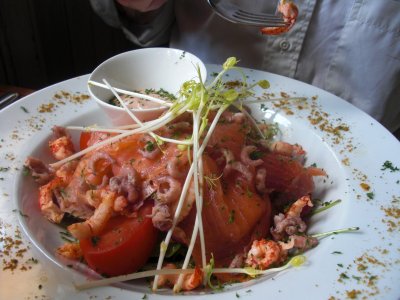
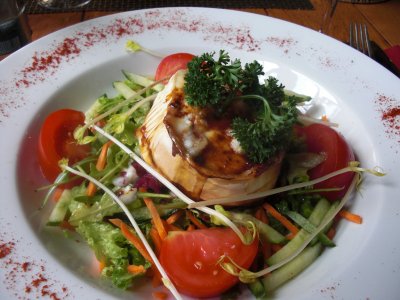 David ordered the house salad, which was covered with slices of smoked salmon and peeled gray shrimp and crayfish tails (called "river lobster" in Flemish). A pink dressing was served on the side. I got the salad of hot goat cheese with honey and lemon thyme, which turned out to be a slab (bigger than a can of tuna) from a large log of cheese, dressed with honey and thyme and broiled until caramelized and melty, then plopped on top of a salad. Both were garnished with tall, tasty sprouts (pea, I think). Both delicious. I drank water, but David spotted iced tea on the menu and ordered that. It turned out to be "Nestea Brisk Lemon," in a bottle, and was carbonated! Very lemony but not too sweet and very good. On the muzak, there it was again, Wailing Woman's trade-mark song—"IIIIII will all ways luv yoooooooooooooooo!"—although this time, it sounded like Dolly Parton rather than Whitney Houston herself.
David ordered the house salad, which was covered with slices of smoked salmon and peeled gray shrimp and crayfish tails (called "river lobster" in Flemish). A pink dressing was served on the side. I got the salad of hot goat cheese with honey and lemon thyme, which turned out to be a slab (bigger than a can of tuna) from a large log of cheese, dressed with honey and thyme and broiled until caramelized and melty, then plopped on top of a salad. Both were garnished with tall, tasty sprouts (pea, I think). Both delicious. I drank water, but David spotted iced tea on the menu and ordered that. It turned out to be "Nestea Brisk Lemon," in a bottle, and was carbonated! Very lemony but not too sweet and very good. On the muzak, there it was again, Wailing Woman's trade-mark song—"IIIIII will all ways luv yoooooooooooooooo!"—although this time, it sounded like Dolly Parton rather than Whitney Houston herself.
Back at the hotel, I sat in the lobby watching the Tour de France and reading while David practiced his talk again in the room, and shortly after that, it was time to change and head off to the welcoming reception of the meiofauna congress.
Written 13 July 2010
FourtIMCo, the 14th International Meiofauna Congress, is the largest ever—200 registrants, plus some "accompanying persons." Only a dozen or so came from the USA, and almost half of those are foreign nationals currently working in the USA. The actual Americans are all rather senior, and the representation from Africa and South America is also rather low; clearly, the next generation of meiobenthothologists will be centered in Europe. No one from the New Zealand or Japanese labs came this time.
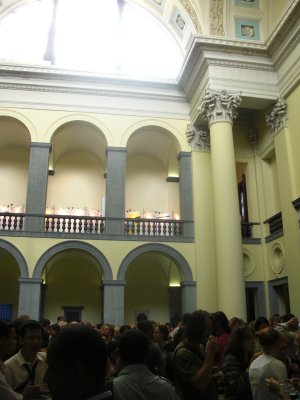 The congress is being held this year in the Aula Academica of the University of Ghent, which currently considers itself the premier university of Belgium. The university is relatively young, less than 200 years old, and when it was founded, the city constructed a manificent building to serve as its centerpiece—the image of its beautifully proportioned and imposingly pillared façade is still the logo of the university. The areas we're using are its gorgeous marble foyer (at the right, shown over the heads of the crowd; coffee breaks, receptions, etc. are held there, and the 150 (!) posters are set up, each with its own individual spotlight, on the gallery that runs around its walls at second-floor height) and the beautiful circular auditorium under its ornate rotunda, where the oral presentations take place (the whole meiofauna congress is always single-session; everyone attends every paper). Reception, registration, rows and rows of coat racks, and the table bearing dozens (hundreds?) of items contributed for the Svedmark Fund raffle are in a large, much less ornate room off the foyer. The building is extremely well known locally—when I asked the hotel clerk to mark it on our map, I got only as far as "the Aula . . ." before she knew exactly what I meant. It's prononced "OWL-ah" and is cognate with "hall."
The congress is being held this year in the Aula Academica of the University of Ghent, which currently considers itself the premier university of Belgium. The university is relatively young, less than 200 years old, and when it was founded, the city constructed a manificent building to serve as its centerpiece—the image of its beautifully proportioned and imposingly pillared façade is still the logo of the university. The areas we're using are its gorgeous marble foyer (at the right, shown over the heads of the crowd; coffee breaks, receptions, etc. are held there, and the 150 (!) posters are set up, each with its own individual spotlight, on the gallery that runs around its walls at second-floor height) and the beautiful circular auditorium under its ornate rotunda, where the oral presentations take place (the whole meiofauna congress is always single-session; everyone attends every paper). Reception, registration, rows and rows of coat racks, and the table bearing dozens (hundreds?) of items contributed for the Svedmark Fund raffle are in a large, much less ornate room off the foyer. The building is extremely well known locally—when I asked the hotel clerk to mark it on our map, I got only as far as "the Aula . . ." before she knew exactly what I meant. It's prononced "OWL-ah" and is cognate with "hall."
In 1983, we met at a different venue, so this is our first view of the Aula; the organizers were extremely pleased to be able to get it, as it's apparently the locale of all the most solemn and/or festive ceremonies of the city. In particular, the European Commission is meeting in Ghent just now (Belgium has just assumed the leadership of the EU, for the next six months), so the streets are full of police, keeping an eye on all the dignitaries, but they must be meeting somewhere else. We've encountered the police, but not, so far as we can tell, the dignitaries. Also in progress are preparations for the 10-day Festival of Ghent which begins Saturday, just as FourtIMCo ends, so temporary stages are being set up everywhere, including several on barges in the river!
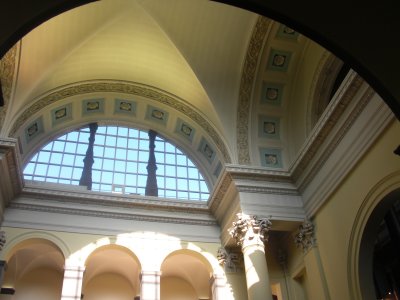
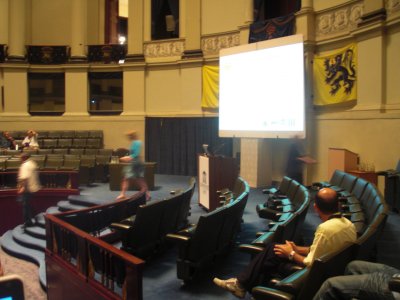 At the left is the ceiling of the foyer, above the posters (the blazing central chandelier makes the rotunda over the auditorium difficult to photograph). At the right is a vew of the circular auditorium.
At the left is the ceiling of the foyer, above the posters (the blazing central chandelier makes the rotunda over the auditorium difficult to photograph). At the right is a vew of the circular auditorium.
The walk from our hotel to the Aula is between 10 and 15 minutes, and we have the choice of walking along the river or of window shopping a block or two inland. We prospected all the way for restaurants serving breakfast, but the only ones we found only open at 9 a.m., too late for our purposes, so it looks as though we'll be stuck eating the hotel's breakfast, which is 15 euros/head!
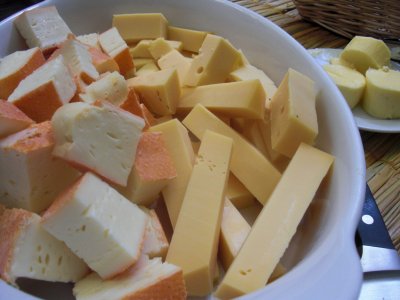
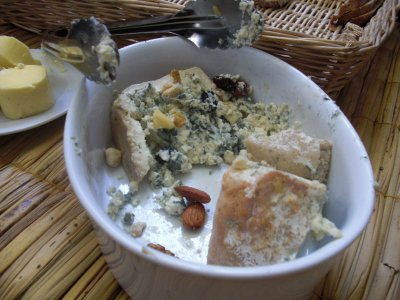 The opening reception is always fun, because it's where we meet and greet colleagues we only ever see every three years, at this meeting, and because the organizers always take the opportunity to showcase local hors-d'oeuvres. This year's assortment was delicious. We started with cheeses, from left to right, Herve, vieux de Bruges, and bleu des moines (note also the cylinders of butter on the side and the large basket of bread). The Brie look-alike was also there, but I didn't photograph it—it looks just like Brie.
The opening reception is always fun, because it's where we meet and greet colleagues we only ever see every three years, at this meeting, and because the organizers always take the opportunity to showcase local hors-d'oeuvres. This year's assortment was delicious. We started with cheeses, from left to right, Herve, vieux de Bruges, and bleu des moines (note also the cylinders of butter on the side and the large basket of bread). The Brie look-alike was also there, but I didn't photograph it—it looks just like Brie.
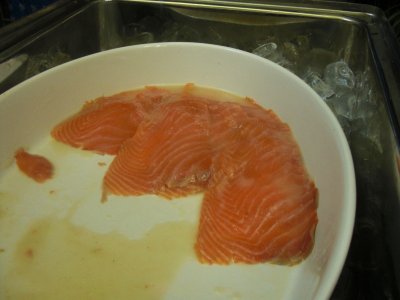
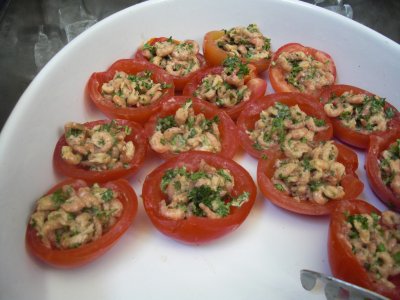 Next came platters of smoked salmon, napped with a delicious mustard vinaigrette, and of tomatoes stuffed with tiny gray shrimp (so far the best shrimp we've had, flavorful and perfectly seasoned. Whenever a platter was depleted, like this one of salmon, it was whisked away and replaced with a full one. The reception went on for hours, but the food never gave out, nor did the beverages—red and white wines, orange juice, and several beers, each poured into its own distinctive glass, including the latest thing for summer: strawberry-cherry kriek served over ice. Bottled water was poured on demand, but only into wine glasses—they wouldn't give me one of the 16-oz. beer glasses.
Next came platters of smoked salmon, napped with a delicious mustard vinaigrette, and of tomatoes stuffed with tiny gray shrimp (so far the best shrimp we've had, flavorful and perfectly seasoned. Whenever a platter was depleted, like this one of salmon, it was whisked away and replaced with a full one. The reception went on for hours, but the food never gave out, nor did the beverages—red and white wines, orange juice, and several beers, each poured into its own distinctive glass, including the latest thing for summer: strawberry-cherry kriek served over ice. Bottled water was poured on demand, but only into wine glasses—they wouldn't give me one of the 16-oz. beer glasses.
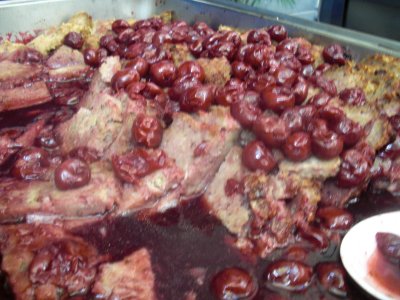
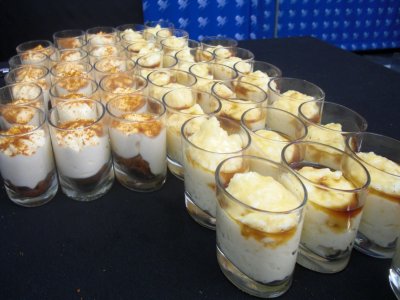 Finally, they served a local specialty, meatloaf (veal?) with sour-cherry sauce—excellent! Dessert was a choice of rice pudding with caramel syrup or "speculoos" cookies topped with cream. Tiny metal forks and spoons were provided with which to eat all these, and waiters circulated constantly, snatching away used dishes and empty glasses and replenishing the supplies of new ones.
Finally, they served a local specialty, meatloaf (veal?) with sour-cherry sauce—excellent! Dessert was a choice of rice pudding with caramel syrup or "speculoos" cookies topped with cream. Tiny metal forks and spoons were provided with which to eat all these, and waiters circulated constantly, snatching away used dishes and empty glasses and replenishing the supplies of new ones.
Throughout the meeting, the foyer was dotted with round standing-height tables, with folding legs. For coffee breaks, they are topped by little round table cloths and bowls of decorative pebbles and candles. By night, each one wears a slinky black knit sheath that covers it top to bottom and hides the folding legs. Very attractive.
previous entry
List of Entries
next entry
 Here, at last, is a photo of part of the rather vast breakfast buffet at the Marriott Brussels, on our last morning at the hotel. Along the counter in front of the chef is the row of large chafing dishes. On the wall to the right of that you can see the three large metal milk dispensers and many jars of cereal. On a table nearer the camera are six white cylindrical crocks full of cut fruit, multitiered wire racks full of whole fruit, and liter bottles of sparking and still water. The breads and pastries are out of sight to the right of the photo.
Here, at last, is a photo of part of the rather vast breakfast buffet at the Marriott Brussels, on our last morning at the hotel. Along the counter in front of the chef is the row of large chafing dishes. On the wall to the right of that you can see the three large metal milk dispensers and many jars of cereal. On a table nearer the camera are six white cylindrical crocks full of cut fruit, multitiered wire racks full of whole fruit, and liter bottles of sparking and still water. The breads and pastries are out of sight to the right of the photo. No trouble getting a cab at the train station, so we were whisked rapidly to our hotel, the Gravensteen, so called because it's just yards from Gravensteen Castle, the seat of the Counts of Flanders. David says he remembers it vividly from our 1983 visit, when we were shown its museum of torture instruments, which still haunts his dreams. Here's the view of the castle from our hotel room, over the roofs of the neighboring houses. The front of the hotel is much closer to it. To the right of it, out of this photo and nearly as close, is another Great Crane of Europe.
No trouble getting a cab at the train station, so we were whisked rapidly to our hotel, the Gravensteen, so called because it's just yards from Gravensteen Castle, the seat of the Counts of Flanders. David says he remembers it vividly from our 1983 visit, when we were shown its museum of torture instruments, which still haunts his dreams. Here's the view of the castle from our hotel room, over the roofs of the neighboring houses. The front of the hotel is much closer to it. To the right of it, out of this photo and nearly as close, is another Great Crane of Europe. 
 David ordered the house salad, which was covered with slices of smoked salmon and peeled gray shrimp and crayfish tails (called "river lobster" in Flemish). A pink dressing was served on the side. I got the salad of hot goat cheese with honey and lemon thyme, which turned out to be a slab (bigger than a can of tuna) from a large log of cheese, dressed with honey and thyme and broiled until caramelized and melty, then plopped on top of a salad. Both were garnished with tall, tasty sprouts (pea, I think). Both delicious. I drank water, but David spotted iced tea on the menu and ordered that. It turned out to be "Nestea Brisk Lemon," in a bottle, and was carbonated! Very lemony but not too sweet and very good. On the muzak, there it was again, Wailing Woman's trade-mark song—"IIIIII will all ways luv yoooooooooooooooo!"—although this time, it sounded like Dolly Parton rather than Whitney Houston herself.
David ordered the house salad, which was covered with slices of smoked salmon and peeled gray shrimp and crayfish tails (called "river lobster" in Flemish). A pink dressing was served on the side. I got the salad of hot goat cheese with honey and lemon thyme, which turned out to be a slab (bigger than a can of tuna) from a large log of cheese, dressed with honey and thyme and broiled until caramelized and melty, then plopped on top of a salad. Both were garnished with tall, tasty sprouts (pea, I think). Both delicious. I drank water, but David spotted iced tea on the menu and ordered that. It turned out to be "Nestea Brisk Lemon," in a bottle, and was carbonated! Very lemony but not too sweet and very good. On the muzak, there it was again, Wailing Woman's trade-mark song—"IIIIII will all ways luv yoooooooooooooooo!"—although this time, it sounded like Dolly Parton rather than Whitney Houston herself. The congress is being held this year in the Aula Academica of the University of Ghent, which currently considers itself the premier university of Belgium. The university is relatively young, less than 200 years old, and when it was founded, the city constructed a manificent building to serve as its centerpiece—the image of its beautifully proportioned and imposingly pillared façade is still the logo of the university. The areas we're using are its gorgeous marble foyer (at the right, shown over the heads of the crowd; coffee breaks, receptions, etc. are held there, and the 150 (!) posters are set up, each with its own individual spotlight, on the gallery that runs around its walls at second-floor height) and the beautiful circular auditorium under its ornate rotunda, where the oral presentations take place (the whole meiofauna congress is always single-session; everyone attends every paper). Reception, registration, rows and rows of coat racks, and the table bearing dozens (hundreds?) of items contributed for the Svedmark Fund raffle are in a large, much less ornate room off the foyer. The building is extremely well known locally—when I asked the hotel clerk to mark it on our map, I got only as far as "the Aula . . ." before she knew exactly what I meant. It's prononced "OWL-ah" and is cognate with "hall."
The congress is being held this year in the Aula Academica of the University of Ghent, which currently considers itself the premier university of Belgium. The university is relatively young, less than 200 years old, and when it was founded, the city constructed a manificent building to serve as its centerpiece—the image of its beautifully proportioned and imposingly pillared façade is still the logo of the university. The areas we're using are its gorgeous marble foyer (at the right, shown over the heads of the crowd; coffee breaks, receptions, etc. are held there, and the 150 (!) posters are set up, each with its own individual spotlight, on the gallery that runs around its walls at second-floor height) and the beautiful circular auditorium under its ornate rotunda, where the oral presentations take place (the whole meiofauna congress is always single-session; everyone attends every paper). Reception, registration, rows and rows of coat racks, and the table bearing dozens (hundreds?) of items contributed for the Svedmark Fund raffle are in a large, much less ornate room off the foyer. The building is extremely well known locally—when I asked the hotel clerk to mark it on our map, I got only as far as "the Aula . . ." before she knew exactly what I meant. It's prononced "OWL-ah" and is cognate with "hall."
 At the left is the ceiling of the foyer, above the posters (the blazing central chandelier makes the rotunda over the auditorium difficult to photograph). At the right is a vew of the circular auditorium.
At the left is the ceiling of the foyer, above the posters (the blazing central chandelier makes the rotunda over the auditorium difficult to photograph). At the right is a vew of the circular auditorium.
 The opening reception is always fun, because it's where we meet and greet colleagues we only ever see every three years, at this meeting, and because the organizers always take the opportunity to showcase local hors-d'oeuvres. This year's assortment was delicious. We started with cheeses, from left to right, Herve, vieux de Bruges, and bleu des moines (note also the cylinders of butter on the side and the large basket of bread). The Brie look-alike was also there, but I didn't photograph it—it looks just like Brie.
The opening reception is always fun, because it's where we meet and greet colleagues we only ever see every three years, at this meeting, and because the organizers always take the opportunity to showcase local hors-d'oeuvres. This year's assortment was delicious. We started with cheeses, from left to right, Herve, vieux de Bruges, and bleu des moines (note also the cylinders of butter on the side and the large basket of bread). The Brie look-alike was also there, but I didn't photograph it—it looks just like Brie.
 Next came platters of smoked salmon, napped with a delicious mustard vinaigrette, and of tomatoes stuffed with tiny gray shrimp (so far the best shrimp we've had, flavorful and perfectly seasoned. Whenever a platter was depleted, like this one of salmon, it was whisked away and replaced with a full one. The reception went on for hours, but the food never gave out, nor did the beverages—red and white wines, orange juice, and several beers, each poured into its own distinctive glass, including the latest thing for summer: strawberry-cherry kriek served over ice. Bottled water was poured on demand, but only into wine glasses—they wouldn't give me one of the 16-oz. beer glasses.
Next came platters of smoked salmon, napped with a delicious mustard vinaigrette, and of tomatoes stuffed with tiny gray shrimp (so far the best shrimp we've had, flavorful and perfectly seasoned. Whenever a platter was depleted, like this one of salmon, it was whisked away and replaced with a full one. The reception went on for hours, but the food never gave out, nor did the beverages—red and white wines, orange juice, and several beers, each poured into its own distinctive glass, including the latest thing for summer: strawberry-cherry kriek served over ice. Bottled water was poured on demand, but only into wine glasses—they wouldn't give me one of the 16-oz. beer glasses.
 Finally, they served a local specialty, meatloaf (veal?) with sour-cherry sauce—excellent! Dessert was a choice of rice pudding with caramel syrup or "speculoos" cookies topped with cream. Tiny metal forks and spoons were provided with which to eat all these, and waiters circulated constantly, snatching away used dishes and empty glasses and replenishing the supplies of new ones.
Finally, they served a local specialty, meatloaf (veal?) with sour-cherry sauce—excellent! Dessert was a choice of rice pudding with caramel syrup or "speculoos" cookies topped with cream. Tiny metal forks and spoons were provided with which to eat all these, and waiters circulated constantly, snatching away used dishes and empty glasses and replenishing the supplies of new ones.